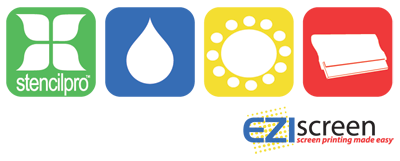Plastisol and Solvent Based Inks - Why they are no longer used for fabrics
Plastisol is a general term used to describe the most common form of solvent based chemical ink, composed primarily of PVC (polyvinylchloride) resin and plasticizer. Original plastisol inks were highly solvent, nowdays they have much less solvent and are called a thermoplastic ink, as the ink is thermal and will remelt if in contact with a hot surface such as an iron - meaning garments mys be indirectly heat set or flash cured.
Whilst an old technology, Plastisol inks remailn widely used by professional printers as they offer advantages over water based rivals when used with fully automated printing equipment, however with the the development of the new generation Aquatex inks today there are often more disadvantages to using Plastisol than advantages for manual printing.
15 years ago there were few other viable alternatives to Plastisol for printing dark coloured fabrics as waterbased inks did not provide a solid print onto black. With the introduction of the new generation Opaque Fabric Inks, this issues was solved and in fact enabled Aquatex ink to progress even further ahead with even higher quality inks for black than plastisol can provide without the use of additives.
Advantages
Solvent base resists drying in the air or screen - can be left overnight
Does not clog in the ink lines/ tubes feeding automated printing equipment
Good adhesion to synthetic materials (when the correct type used of course)
Disadvantages
A different inks type required for each type of material = higher ink costs
Must be pritned 'off contact' as ink sits on top of garment
Plastisol inks do not dye the fibre - creats a film above the garment easily felt by the hand
Plastisol will crack after just a short period of use (everyone has felt the rubbery feel of the t-shirt and then watched the print crack after only a few washes)
Print can not be ironed directly (garment must be ironed from the back)
Not suitable for dry cleaning
Additives can upset the balance of the ink, cause the ink to never cure even after setting!
Set up costs can be very high as specialised, expensive Flash Cure units are required to set the ink
Professional ventilation is required during printing to vent solvent vapours
Screen clean-up requires chemical and solvents
Expensive wash-up tank with filtration traps are required to stop chemicals and solvents entering water system (hazadous chemical regulations apply)
Storage of chemicals can be a major concern in a home or small business environment (hazadous chemical regulations apply)
How Plastisol works and differs to Aquatex
Aquatex pigments bond to the actual fibres of the material creating a permanent, soft, flexible and dry cleanable print.
Plastisol inks do not dye the fibre, they bond around the outside of the fibres, sitting on top to create a film above the garment. By sitting on top or the fibres the print is easily cracked or broken when the fabric is stretched/ pulled/ rolled/ flexed as the bonds is more easily broken than that of a penetrating ink.
Why do printers continue to use Plastisol?
Change can be a difficult thing for printers both set in thier ways and having purchased tens of thousands of dollars orthof printing equipment. You can't teach an old dog new tricks.
Sometimes it's easier to leave the old methods in place even though they are more expensive and more diffucult than newer equipment. If a customer is using Plastisol already then they have invested a great deal of money into the flash curing unit/s required to set the inks - spending thousands of dollars on equipment then finding out it's no longer used can be a hard thing for anyone to accept.
It's less common now to find printers stuck in old methods, as those who have not progressed in the last 10 years find it near impossible to compete with people who do make a change newer technologies and increase the profitability of thier business. It's printing evolution.
If your using a fully automated screen system then this is a suitable product, it wont give you the best result, but it's ideally suited to the printing method.
Plastisol V's Water based
Ink Type |
Curing |
Ease of Printing |
Opacity |
Feel/ Hand |
Cost |
Waste Recovery |
| Aquatex Fabric Ink | Easy |
Easy |
Med-High |
Soft |
Low-Mod |
Excellent |
| Plastisol |
Fair |
Fair |
Low (Standard) High (with additive) |
Med-Heavy |
Mod-High |
Fair |
Ink Type |
Aquatex (water based) |
Plastisol (solvent based) |
| T-shirts - light coloured | Excellent |
Excellent |
| T-shirts - dark coloured | Good |
Poor (Good when additives used) |
| Nylon Jackets | Fair |
Good |
| Towels | Excellent |
Poor |
| Fabric (Yardage) | Excellent |
Poor |
Plastisol is not a support application
Plastisol is no longer a product or printing method supported as there are simply easier, better and cheaper options available for printing t-shirts and fabrics.
You can of course continue to use any Plastisol inks with StencilPro™ films, however we are just no longer able to provide technical support.

